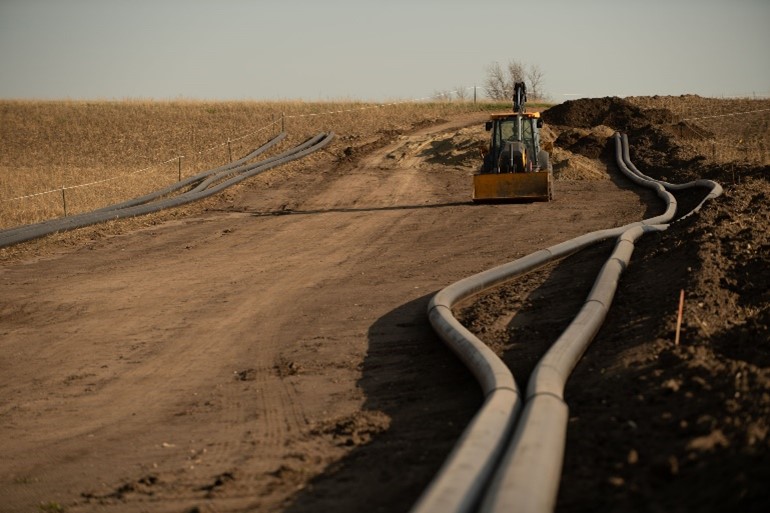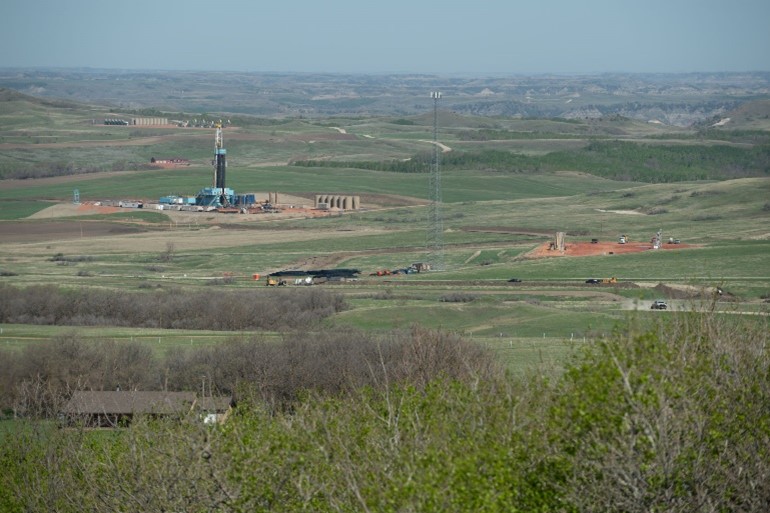October 2023, Vol. 250, No. 10
Features
Bakken Case Study: Expanding Operations Depends on Thick-Walled HDPE Pipe
Special to Pipeline & Gas Journal
(P&GJ) – As Continental Resources expands its operation in Dunn County, North Dakota, an important component is the use of high-density polyethylene (HDPE) pipe that was selected not only for its integrity but also because it can be installed without scaring the environment.
The pipe is used to convey water from production well sites to the company’s saltwater disposal (SWD) facility. This is the fourth phase of the Dragonfly Gathering System. In total, the saltwater gathering project used 17,000 feet of the HDPE pipe.
“It’s a pretty extensive project on the west side of the Killdeer Mountains in tough terrain,” said Kathryn Liska, senior staff engineer for Continental. “We did several very long bores, one about 2,500-foot long, and one just over 4,000-foot long in an area that has about a 500-foot change in elevation.”
Based in Oklahoma City, Continental is the largest leaseholder and the largest producer in the nation’s premier oil field, the Bakken play of North Dakota and Montana.
Designed to accept up to 36,000 bpd of produced water, the new facility includes the SWD well, pumps, SCADA monitoring systems, site storage tanks and pipeline inlet equipment with associated SCADA monitoring, all on a small footprint site of 5.5 acres in western North Dakota. Water temperature is typically in the range of 80-90 degrees F, with pipeline pressures ranging from 150-200 psi.
SWD wells in this area are generally in excess of 5,000 feet deep. Delivering produced water by pipeline to this facility reduces area traffic by approximately 250 trucks per day. This translates to increased traffic safety, less wear and tear on the infrastructure plus a reduction in CO2 emissions that could be as much as 335,800 kg of CO2 a year.
The facility processes the liquid and separates any residual oil from the water. The water then can be injected into the SWD, and the oil sold to the market. There can be anywhere from four to ten barrels of brackish water produced for each barrel of oil.
Well stimulation is an oil and gas term for using high-pressure water and sand to crack a rock formation deep underground. Pumping this fluid into a drilled well opens up tiny fissures that are up to several tenths of an inch wide, allowing oil and natural gas resources trapped in tight rocks to flow back through the pipes and up to the surface where it is captured for energy use.
“Well stimulation is a highly technical, precise and proven method,” Liska said. “Producing more energy while using fewer resources makes good economic sense and reflects the responsibility we feel toward the communities and environment in which we operate.”
High-density polyethylene was chosen for the project because of its flexibility and resistance to corrosion and its ability to withstand ground movement. With a projected 100-year lifespan, it’s not affected by ground conditions and is going to be there for longer than the life of the project, the company said.
Continental is using SDR 7 HDPE PE 4710 made by Pipeline Plastics, which a thick wall of more than one-inch, with an outside diameter of either 10 or 12 inches. The design and thickness are based on pressure ratings and the changes in elevation. Part of the project goes through a Wildlife Management Area up in the Killdeer Mountains and extensive work was done with the North Dakota Game and Fish Department.
“We did some extensive bores further than we normally would’ve chosen based on the terrain. But we did that to minimize impact through the area, so we’re not open-cutting those areas,” Liska said. “It just minimizes the activity through the Game and Fish’s property and to minimize any above ground disturbance. They basically won’t even know we’re there.”
All of the joint connections were pre-made and boring will take place well below the surface.
For the HDD, the crew did a 12.25-inch pilot hole drilled to establish the bore path direction. At the point where it comes out of the ground, they reattached a larger-diameter bore – in this case, a 20-inch drill – and then pulled it back through the same path, making the hole the size needed for the HDPE pipe. Then, the new pipeline was pulled through the opening.
The drill rig was an American Auger 440, with a pulling force capacity of 440,000 pounds and a torque capacity of 60,000 ft/lb. to go through the gravely loam soil the streaks of clay. The larger HDD that was 250 feet down took six weeks, and the smaller bore that took four weeks, was 190 feet down. Both were done by the Continental crew of 11. The underground path went beneath roads, gulches plus native prairielands with Dakota skipper habitat.
“[We] are required to use pipe that is corrosion-resistant,” Liska said. “We could use coated steel, or composite pipe which is still coated with polyethylene or lined with it, or even fiberglass. But the HDPE is faster and more reliable and can be used with our pressure rating requirement, so it’s by far our first choice.”
Being considerate of the environment is important to the company and also to its employees, the company said. Brock Seibel is Continental’s Produced Water Gathering foreman for the company’s produce water gathering and disposal systems.
“Being a native North Dakotan and a hunter and a fisherman, knowing that we are going under some wildlife management areas, protecting these lands is important to me,” Seibel said. “I appreciate that Continental goes above and beyond to do exactly what we say we’re going to do to protect these lands.”
“The HDPE PE 4710 pipe has the strength and also the flexibility to withstand the pullback of HDD installation,” said Randy Knapp, engineering director of PPI’s Energy Piping Systems. “The elongation of the pipe is rated at greater than 500%, according to ASTM D638.”
With a wall thickness of the DR 7, 10-inch pipe is a little more than 1.5 inches. Even with that wall thickness the pipe can follow the contours of the land, and the entrance and exit pits. Being a bimodal resin, PE 4710 provides strength and stiffness with a high degree of stress crack resistance plus ease of processing and extrusion, he added.
According to David Fink, president of the Plastics Pipe Institute, Inc. (PPI), being able to respect environmentally sensitive areas, such as this land near the Killdeer Mountain Wildlife Management Area is one of the key benefits of using HDPE pipe.
“Miles of pipe was used to create the Continental system and because HDD was used, the surface ground was virtually untouched,” said Fink “Plus, the pipe with its heat-fused joints between sections provides a leak-free pipeline that is also unaffected by seismic shifts or the hot corrosive water that passes through it.”
About PPI: The Plastics Pipe Institute, Inc. (PPI) is the major North American trade association representing the plastic pipe industry and is dedicated to promoting plastic as the materials of choice for pipe and conduit applications. PPI is the premier technical, engineering and industry knowledge resource publishing data for use in the development and design of plastic pipe and conduit systems. Additionally, PPI collaborates with industry organizations that set standards for manufacturing practices and installation methods. For more information, visit www.plasticpipe.org/energypipingsystems







Comments